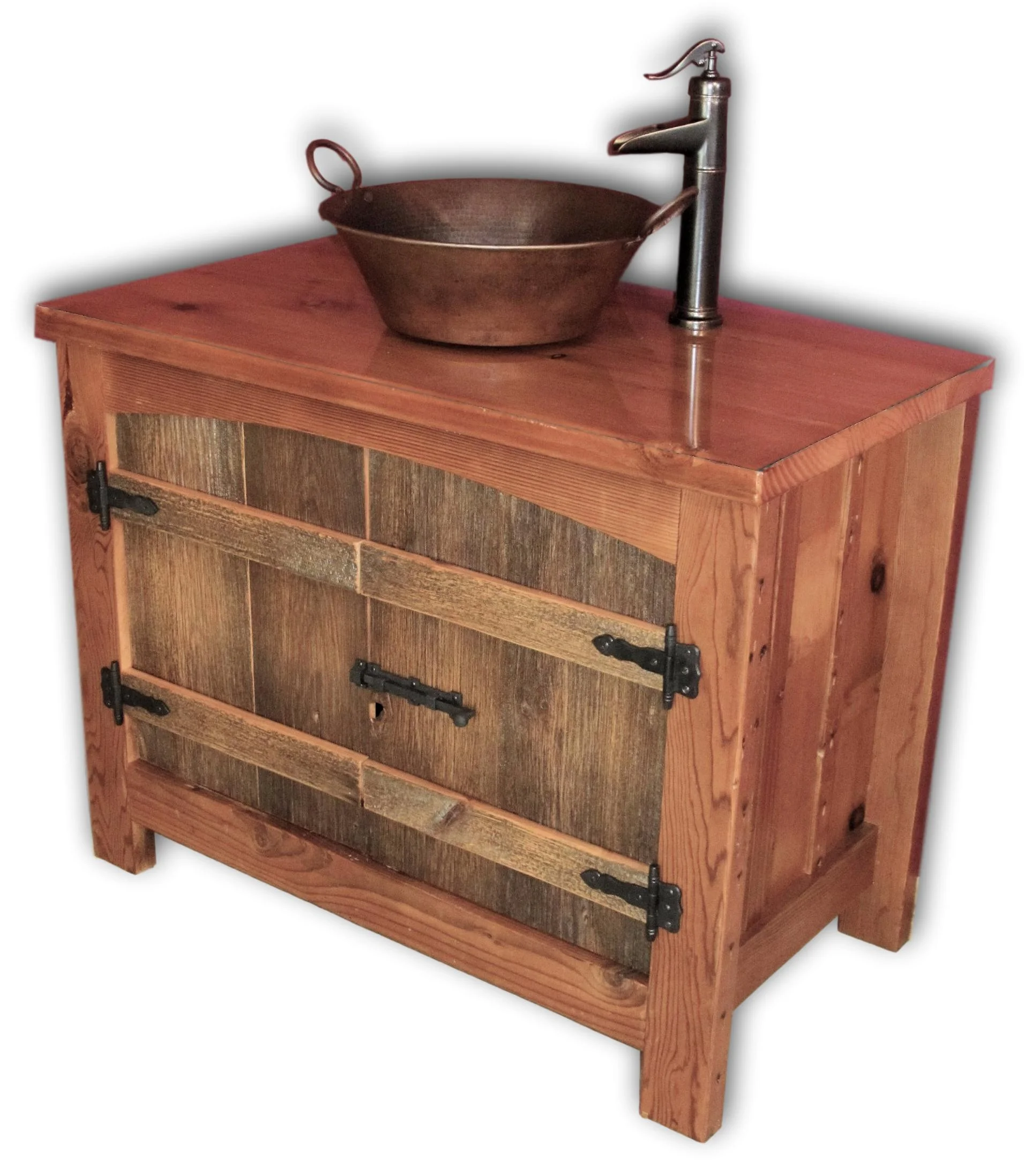Quote Request Form for Rustic Bathroom Vanities Made From Authentic Barnwood, Rustic Timber Lumber or Logs.
Reclaimed Wood For Kitchen Cabinets and Furniture
Building new furniture from repurposed Lumber decreases our footprint and is environmentally conscientious
Furniture made entirely from reclaimed lumber is an appealing method for recycling structures from our past. For example, decades ago vast areas of farmland were dotted with barns made from locally sourced timbers cut from virgin forests. The trees in these forests had been growing for hundreds of years and in modern times, trees never experience the opportunity to grow to this size before they are cut down and harvested. Although many trees are planted in the US every year, new lumber is so vastly different from the ancient trees that had lengthy growing periods, which is why modern lumber such as pine differs so dramatically from the antique heart pine that was used by American settlers. Heart pine is much more dense, for example, because the trees grew for so much longer as evidenced by the incredibly large number of rings that are seen in heart pine logs. Modern pine is softer because those trees are cut and sent to the lumber mill long before they have a chance to develop the many rings and the unique character of heart pine lumber – which is only primarily available through reclamation.
While barns are still used in farming areas throughout the country, the older structures frequently need to be taken down in many locations where newer steel barns have been constructed or where they are no longer being used by residents on a homestead. Some companies are dedicated to reclaiming the wood from the barns that sit empty and unused and doing so entails removing the wood without damaging it. While there is always some amount of rotting wood in century old barns and out buildings, most often reclaimers find that the building interior has a good amount of antique wood that is in excellent shape which makes it suitable for making furniture or wall siding. Using reclaimed barnwood has benefits that are twofold in that furniture artisans are utilizing a part of our history to craft unique furnishings while reducing waste and at the same time, they are reducing the number of trees that need to be cut down to create their handmade furniture pieces. In the past, barns would be burned down or bulldozed under, destroying perfectly good wood that could have been cleaned and used to build something new. Fortunately, it has become more common practice to be mindful of recycling, which has led to the opportunity to use beautifully patinaed wood for hand crafting furnishings that include barn wood tables or even reclaimed wood kitchen cabinets.
Weathered Gray Reclaimed Barnwood Kitchen designed and built by Vienna Woodworks LLC. The comapny ships full kitchens nationwide and to Canada.
This Kitchen made by ViennaWoodworks.com is made from weathered gray barn wood that is from barns taken down within fifty miles of the shop. The wood is 80 to 100 years old. If you were to order a sample of any of their barn wood from them, you would notice right away that it has an antique patina, and there will be no question that this wood is very old!
The reclaimed barn wood furniture that is built at Vienna Woodworks is made using barnwood from barns taken down in the Midwest that are typically over a hundred years old.
Brown reclaimed barn wood table and chairs made from authentic barn wood. No stain was used on these furniture pieces since the rich patina that develops on the wood over a hundred years is what makes this product unique from manufactured furniture.
Barnwood Coffee table with Copper Inlay by Vienna Woodworks LLC.
Vienna Woodworks includes informational pages on their company website that describe the process for procuring and working with reclaimed barnwood. Chris, the owner, uses specific criteria for choosing his barn wood in order to produce furniture with a truly antique quality: We always use authentic antique wood, and we never use barns that are not at least 80 to 150 years old. Every week we send out many samples to customers so that they can examine our authentic antique barn wood. Our selection of reclaimed wood is beautifully aged. We often get requests from people asking what kind of stain we use on our furniture pieces but there is no such stain, The only product that is applied to our furniture is a clear furniture grade finish, which reveals beautiful knots, antiquing and a rich patina that occurs through the natural process of weathering and cannot be perfectly duplicated through any modern process. In other words, there is no quick way to get an faux patina that looks truly authentic. This process takes place over time, using wood cut from virgin forests so it is not able to be duplicated with modern lumber and chemicals.
We then take this barn wood and clean, buff and sand it so that it is smooth and beautiful. We are able to leave it more rustic or we can also use a special process to make it more smooth and even - the choice is the customer’s! Not all customers like the same level of rustic in their furniture, and we can easily accommodate this! We have been doing so for quite some time, so when you look at our products on our website, you will see variations of rustic in the pieces. Some appear to be smoother, and some look more natural. This is all by customer request. All of our products can be made to whatever level of rustic look that you prefer. Please keep in mind that the more a piece of wood is evened out, and planed on the planer, the less aged patina there will be. The more that is planed off, the less history will be left on the surface. The beautiful tones and colorings (patina) will be shaved off. What is underneath is still beautiful and unique however, The cut and planed edges of the wood will often be lighter in color and it can sometimes look newer until you closely inspect it, and upon inspections you can see the many rings in the wood that indicate that this wood was from a barn that was put up 100 plus years ago, but interestingly, grew in the forest for at least 100 years or more prior to its use! The wood is probably, in reality, over 200 years old! The number of rings indicates the age of the wood - and new wood that you buy at a lumber store, or from barns that are younger than the ones we use doesn't have nearly the number of closely spaced rings, because trees that are now growing in most of the U.S. were planted after the virgin forests were cut down by the settlers years ago. They are not allowed to grow for 100 or more years like the trees used for the lumber in these old barns, so the number of rings is drastically different from the antique wood and the look of the wood is substantially different.
True barn wood also has nail holes and saw marks very often. This is another way to determine its authenticity. Often you will see furniture pieces that are called barn wood, made from various types of rough-cut lumber (which is new lumber). This is easy to spot once you realize the difference. Newer lumber that is rough cut looks a lot like barn wood, and some people prefer this! We have a line of rough-cut timber furniture on our site, but we make sure to differentiate between this and authentic barn wood. The main difference is that you will never see nail holes at all in rough cut new lumber or faux barn wood (unless the builder puts them in himself to give it character). The other tipoff are the saw marks that appear on the surface of the wood. The saw marks in this type of material are from modern saws and look different. The freshly cut saw marks expose the wood in such a way that they look lighter than the real barn wood. This is because they have not had time to age and darken they way the ones on true barn wood have. There are also usually a lot more saw marks made in this material as compared to authentic barn wood. Authentic barn wood saw marks were put there so long ago that the cut from the saw is darkened, almost black, because the wood that was exposed so many years ago has aged. They just have a natural look to them that is essentially impossible to replicate. These marks tend to be more curved and can have a crisscross pattern made from old saws while rough cut lumber often has many vertical marks in it, so it does look more manufactured and less natural in appearance.
Vienna Woodworks has been creating furniture designs for rustic spaces since 2001 when they began building log furniture in Superior, Wisconsin from sustainable forest products. Their line of Hickory Log furniture for example, is made from hickory saplings from Southern United States. Once a sapling is cut, several new growths form on the root system to replace and sustain the hickory growth. Currently a new product the company introduced in 2018 recycles old whiskey barrels into functional furniture pieces such as bar and bathroom sink bases. All of their recycled wood products can be found on their main website at www.viennawoodworks.com. Call Toll Free: 888-625-7570
Barrel Sink Base Vanity crafted by Vienna Industries, LLC






